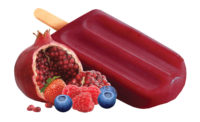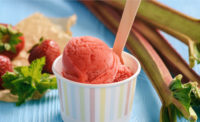Fruit and fruit preparations for frozen desserts
Execution can become critical to the success of any brand
Photo courtesy of bhofack2 on www.gettyimages.com


Vanilla, chocolate and vanilla/chocolate-based flavors, so-called “neutral” flavors, are many times the core of any given frozen dessert product line. Brand equities also extend into “not-so-neutral” flavors including many fruit flavors.
Thus, execution of fruit-flavored ice creams, reduced fat ice creams, frozen yogurts, sherbets, sorbets and such can become critical to the success of any brand. Typically, by sales volume, more than 25% of all ice creams, 50% of all frozen yogurts, and 90% of all sherbets and nearly all sorbets are fruit-flavored. This is the simple part.
Fruit flavors, as characterizing flavors, can be classified by type, acidic versus sweet. Yet, how any given fruit flavor, or fruit preparation, is delivered to the frozen dessert mix, i.e., directly into mix (pre- or post-pasteurization), as a bulky flavor (syrup and/or particulate inclusions), and even as a ribbon, or swirl, of two differing styles/flavors of frozen desserts (e.g., fruit-flavored frozen yogurt swirled into vanilla ice cream; fruit-flavored sorbet swirled into vanilla ice cream) needs careful consideration.
Before considering specific fruits, the following factors relate to the frozen dessert composition into which any fruit, fruit preparation and/or concentrated fruit flavoring(s) would be added:
- Base mix, standard dairy; non-standard dairy; or plant-based.
- Base mix composition, amount/type of fat/oil; milk-solids-not-fat; sugars; other sources non-fat solids; given fruit, fruit preparation or fruit flavor(s) to be used. Are there any necessary/desirable flavor enhancers?
- Brand equity reflecting in characterizing fruit flavor declaration: organic, natural flavors only, natural and artificial flavors, artificial flavors?
Mix analytics to manage:
- Mix density, overrun targets, yields.
- Relative sweetness, some fruit flavors need more or less depending.
- Lactose/glucose as sources of different degrees of “sandiness.”
- Influence of freeze concentration during whipping/freezing.
- Freezing point management including water mobility control.
- Direct/indirect influence on added flavor(s) and color(s).
- Compositional targets: fat, protein, sugars, calories.
- Expectant draw temperature(s).
- Resistance to heat shock through the entire intended shelf-life of the finished food.
- Overall compatibility with brand equity.
Now, on to fruit:
- What specific fruit is being considered? This includes varietals, varietal differences, seasonality, and physical form of the fruit, i.e., whole, slices, dices, puree, juice concentrate(s), dried, etc., including with/without seeds.
- How the fruit is to be prepared (IQF fruit, frozen packed with “protective”, i.e., protect from discoloration, flavor/texture loss, dry or syrup “cap,” etc.) in advance of any actual formulation into a final preparation.
- Composition, chemistry and physics of any formulated fruit preparation; desired compatibility with mix composition.
- When, where, and how much fruit, fruit preparation, and/or flavor should be added? Are these to be added at the flavor tank and/or into soft ice cream via classical particulate or syrup injection, or all three?
- Is the final form of the fruit in the frozen dessert, i.e., size and condition as they relate to desirable fruit identity/show in final packaged frozen dessert, direct-draw soft serve or shake formats?
- Are desirable declarations compatible with the specific brand equity (e.g., “all natural”) or any required content claims, i.e., low-fat, no sugars added, reduced calories, etc.?
- Economics. Is the cost of the final fruit-flavored ice cream compatible with the line-cost-average of the specific product line?
- Food safety: Fruit comes from plants, trees, and other sources exposed to relatively “dirty” growing and harvesting environments. Think physical, chemical and microbiological safety issues. Thus, care is necessary when selecting the right fruit, form, and format through ultimate delivery into the ice cream.
A number of generic approaches pertaining to fruit selection should be considered:
- With/without actual fruit pieces (varying forms, formats, use rates).
- With/without added flavor(s), enhancers, aromatics, compatible acid(s), etc.
- With/without added sweeteners.
- With/without compounded (i.e., “stabilized”) fruit preparations.
In addition, most characterizing flavors are added after pasteurization to cold mix and/or soft ice cream at the ice cream freezer and before packaging. In such cases, fruit flavors (non-bulky flavors) and fruit preparations (bulky flavors) need to comply with one or more of the following:
- Subjected to prior heat treatment to ensure free from pathogenic organisms.
- Have a water activity less than 0.85.
- Have a pH less than 4.7.
- Flavor(s) carried in high alcohol (typically in non-bulky flavors or extracts of flavors; but also think dried fruits).
- Bacterial cultures.
- Fruits and vegetables that have been rendered pathogen-free by processes used to prepare the specific fruit/vegetable ingredient(s).
Now, consider the number of fruit flavor options: strawberry, raspberry, lemon, lime, mango, orange, etc.; varietals of each (i.e., color, flavor, texture, size); seasonality of each; and the change in eating “quality” (flavor, color, texture) of fruit from any given growing location and as any given harvest season progresses.
A lot to contemplate, so, have at it!
Need to learn more on fruit preparations for ice creams? Join Steve and Bill at the 52nd edition of Tharp & Young on Ice Cream: Technical Short Course, Workshops and Clinics, Nov. 30 to Dec. 2, Las Vegas. Multiple registration discounts available.
For more, go to www.onicecream.com or call 281-782-4536 or 913-530-8106.
Looking for a reprint of this article?
From high-res PDFs to custom plaques, order your copy today!






